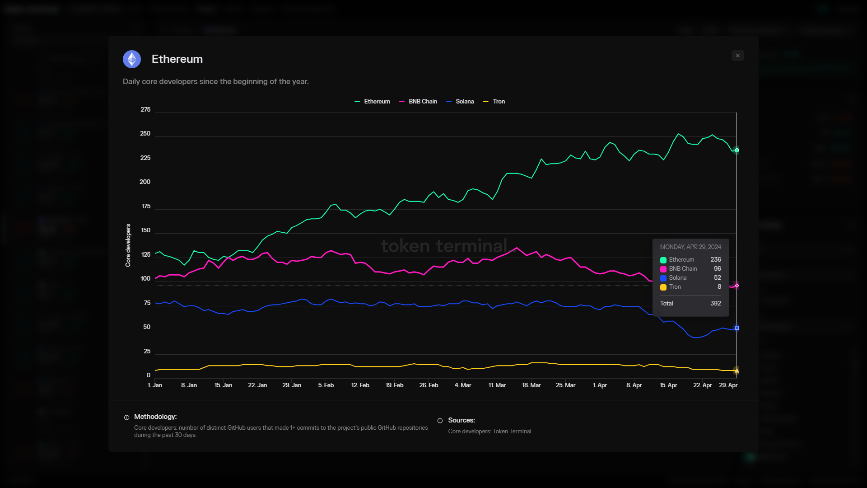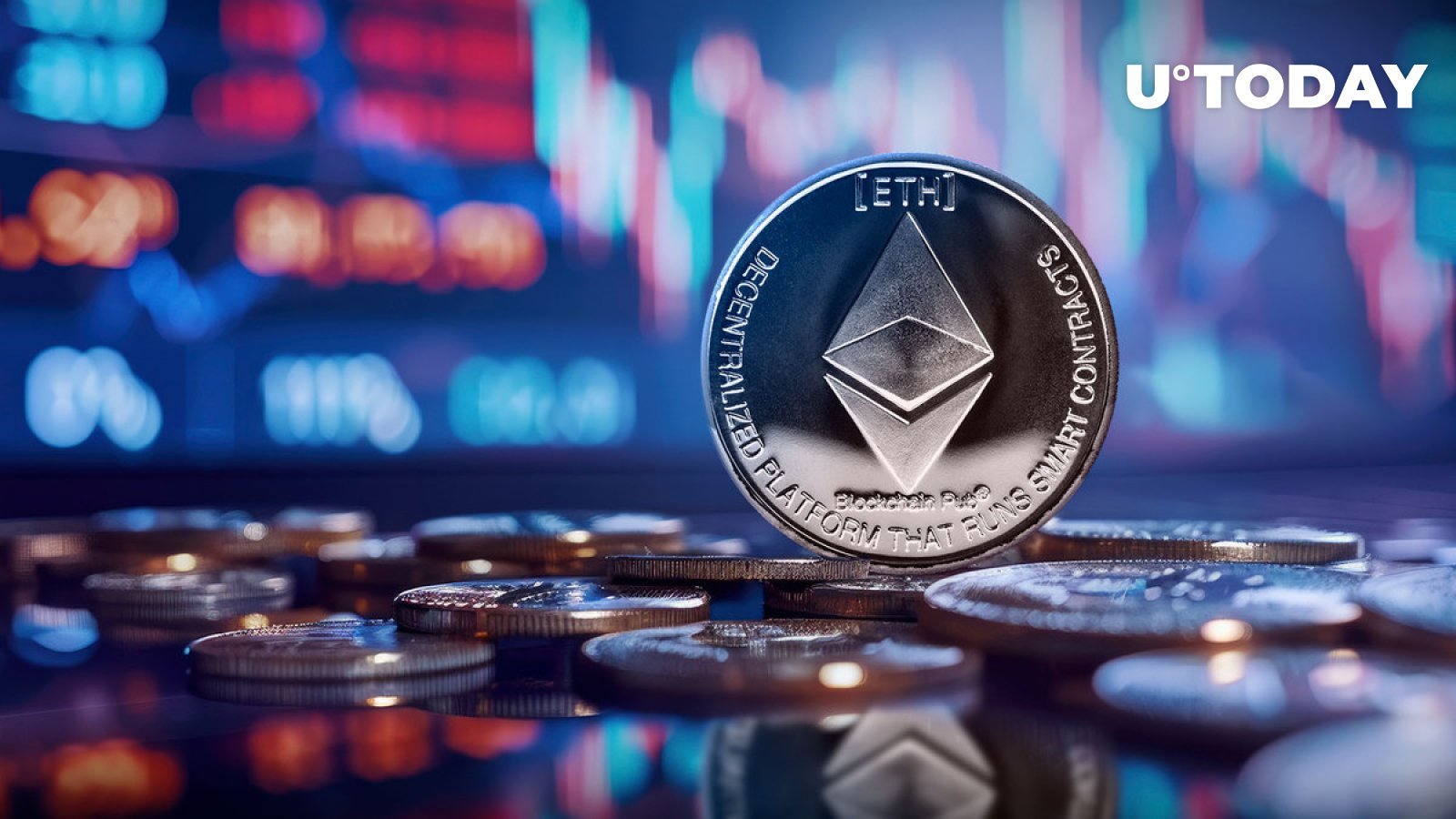Ethereum
Can Tron Overtake Ethereum? – Bitcoin Market Journal

Key Takeaways:
- Tron: Huge in Asian markets despite regulatory scrutiny, powered by Tether.
- Ethereum: Favored in Western markets for its compliance and innovation, powered by USDC.
- Ethereum has a higher market capitalization, while Tron sees greater daily user activity, suggesting different levels of market engagement.
- The potential outcomes for Ethereum and Tron range from one dominating the market, both coexisting, or both being overtaken by a new blockchain.
Before the advent of radar and satellite navigation, sailors often relied on the flight of birds to determine the presence of nearby land masses. Similarly, in the blockchain markets, the “flight patterns” of stablecoins can often tell you quite a lot about the fortunes of a blockchain project.
As of this writing, Tron is leading Ethereum in USDT supply, with $57 billion on Tron versus $50 billion on Ethereum. What might this mean for blockchain investors? Can Tron overtake its older, more popular rival as the premier Layer-1 smart contract blockchain?
In short, which token is the better buy in the long term – ETH or TRX?
In this guide, we analyze the fundamentals, history, and regional dynamics of both Tron and Ethereum to see if we can find a winner.
The Fundamentals
Behind bitcoin, Ethereum is the second largest crypto in the world, with a market cap of $386 billion. At just $10.6 billion, Tron is a distant 13th on the table overall (and 9th if you only look at L1 blockchains). Bitcoin towers above them all, with a market cap of $1.24 trillion.
Token Price and Supply
At the time of writing, ETH was worth $3,169, an increase of 178% year over year and 1557% from its value in Q4 2020. Naturally, this price movement has made ETH a popular option among investors for long-term holding.
TRX presents a study in contrast in many ways. Since its launch in 2017, the token has never ventured above a peak of $0.23 in price. At the start of Q2 2024, 1 TRX is worth $0.120, a 6000% increase since 2017 and 173% year-on-year.
Both ETH and TRX do not have any limits on the number of tokens that can be issued over time. In both blockchains, a set amount of tokens are regularly burnt off to regulate the available supply and maintain an upward price pressure.
Daily Active Users
On Daily Active Users, our favorite metric, Tron is comfortably ahead of its rivals. The network has around 1.9 million daily users. After crossing the one million milestone in 2022, the numbers have remained relatively stable, with noticeable spikes in 2023 and early 2024.
On Ethereum, the number of daily active users is only around 465,000. The graph looks relatively flat over the years, barring a few minor spikes here and there. Although there is a slow upward trend, it is pretty clear that holders of ETH typically use the network less often than TRX owners.
Network Fees
High gas fees have been a perennial problem for the Ethereum network. This has spawned the development of Layer-2 networks (L2s) and sidechains prioritizing lower transaction costs. L2s like Arbitrum and Optimism and sidechains like Polygon offer lower gas fees than the Ethereum mainnet.
Even in 2024, subject to network congestion and demand, gas fees on ETH mainnet can range from less than a dollar to $70 or more. In contrast, transactions on the Tron network usually cost between $1 – $3, subject to network activity.
Further, Tron also offers free transactions. Users willing to stake TRX on the network can enjoy transactions without gas fees. The limits can vary depending on the quantity of TRX staked.
In 2024, Ethereum’s annualized fees were around $2.75 billion, with a monthly fee of $226 million. Meanwhile, Tron reported annualized costs of $1.52 billion and monthly fees of $125 million.
Reputation and Regional Dynamics
Any discussion of the Tron network would be futile without a look at its controversial founder, Justin Sun. A fugitive from the Chinese government, Sun has been accused of everything from insider trading to market making, tax evasion, various forms of financial fraud, money laundering, and more.
Even sections of the Tron white paper were allegedly plagiarized from white papers written by Protocol Labs, another blockchain organization. Sun, who owns the Tron Foundation, was charged by the SEC in 2023 for fraud and violations of US securities laws related to the sale of TRX tokens.
Undoubtedly, investor perception of Tron has been heavily influenced by the negative press generated by Justin Sun over the years. However, despite its early wobbles, Tron has gained traction in key markets outside the US and the EU.
Two key developments were responsible for this:
- The addition of USDT to the Tron blockchain as a TRC20 token
- Partnership with Binance to support the Tron network on the popular exchange
Tron enjoyed the early mover advantage in providing an easily accessible electronic payment system based around a stablecoin, with very low fees and instant transactions. This proved highly attractive in regions that suffered from the following situations:
- Lack of modern banking systems and high cross-border transaction fees (Asia, Africa)
- High levels of inflation that rendered the national currency unusable (Latin America)
- Western sanctions blocking international bank payments (Russia, Iran)
In these regions and China, the users have acute real-world payment needs that Tron effectively meets. Most do not care about Justin Sun’s reputation; many users may not even know his existence.
US regulators have repeatedly targeted USDT and Tron for non-compliance with financial regulations. However, they are both entrenched in the global market due to the early mover advantage—rival options like USDC and Arbitrum arrived much later.
How Ethereum (and USDC) Compares
Regarding reputation, Ethereum’s equivalent to Justin Sun – co-founder Vitalik Buterin – has had no major scandals or controversies associated with him. He is generally recognized as an innovator and pioneer of blockchain technologies.
Ethereum also has a relatively clean reputation, which has aided its adoption as a platform for crypto innovation and investment in Western markets. In tandem, Circle’s USDC stablecoin has emerged as a popular alternative to USDT due to its focus on compliance with US financial regulations.
The critical thing to note is that while ETH is incredibly popular in the West, it is not widely used for real-world solutions like payments. Crypto is primarily seen as a tool for investment and wealth generation through holding or trading.
In contrast, Tron and USDT have gained popularity in Asia, Latin America, Africa, and Russia as they offer viable alternatives where traditional banking and payment systems have failed.
Application Ecosystems
A quick look at Dappradar.com reveals a clear mismatch between the two networks. Ethereum has well over 4,000 apps, with over a dozen showing thousands of unique active wallets (UAWs). Here is a quick look at the top 5 dapps on Ethereum:
- Xterio: A gaming app with over 67k UAWs and transaction volumes of $716k in 24 hours
- Uniswap V3: A popular trading and AMM protocol with 32k UAWs and $2.7b transactions
- 1inch Network: A liquidity and DeFi aggregator with 9.4k UAWs and $225m transactions
- EigenLayer: A radical new restaking protocol with 8.8k UAWs and $392k transactions
- Uniswap V2: The predecessor to V3, with 7.87k UAWs and $137m transactions
Further, Ethereum has over 236 core developers who made over 1.69k code commits in 30 days. According to DeveloperReport.com, the blockchain attracts the maximum number of active developers, with 2,392 as of December 2023.
 Link: https://tokenterminal.com/terminal/projects/ethereum
Link: https://tokenterminal.com/terminal/projects/ethereum
Tron has more modest stats in comparison. Apart from 8 core developers, the blockchain reportedly has only 16 independent developers. The ecosystem is far from thriving, and developer activity seems dead mainly, although the platform has around 1380 apps and protocols.
- PayNet Staking: A high-risk staking app with 743 UAWs
- Degree Crypto Staking: Another decentralized staking app with over 500 UAWs
- Tron NRG: A protocol that allows TRX stakers to rent their energy, with 171 UAWs
- Bitget Swap: A trading wallet with 157 UAWs and $32.6k transactions in 24 hours
- JustLend DAO: A decentralized lending app with 119 UAWs and $277k transactions
These numbers show that Ethereum is way ahead of Tron in terms of ecosystem evolution and developer activity. The vast majority of Tron users are interested only in its USDT payments feature, which is not bad. It has a niche use case that has gained traction in specific parts of the globe.
However, Ethereum is miles ahead when it comes to testing and developing new ways to use blockchain technology. If you are looking for innovative services and apps that could gain mainstream acceptance in the future, you are more likely to find those on Ethereum’s ecosystem.
Scalability and Other Technical Aspects
Ethereum and Tron are highly scalable blockchains, unlike bitcoin, which relies on an energy-intensive proof-of-work consensus model. While Ethereum uses a basic proof-of-stake model, Tron relies on a delegated proof-of-stake consensus mechanism.
Ethereum, in particular, has a significant lead when working on scaling solutions. Dutzende of L2 chains and side chains are currently under development. Tron presently has one primary L2 under development linked to Bitcoin.
Transaction Speeds
Due to the delegated PoS, Tron can process transactions much faster than Ethereum, resulting in a claimed average speed of around 2000 transactions per second (TPS). The Ethereum 2.0 mainnet can only handle between 15 and 30 TPS.
This could change with the addition of newer features like sharding to Ethereum via future updates. Besides, the blockchain already offers faster transaction speeds through sidechains and L2s like Arbitrum (4000 TPS), Polygon (65,000 TPS) and Base (2000 TPS).
Programming Languages
Ethereum is more friendly towards developers as it supports a wide array of programming languages, including Python, Ruby, Rust, Dart, Delphi, Go, Java, and Javascript. In contrast, Tron has adopted a narrower approach, supporting only Python and Solidity.
Future Prospects: Coexistence or Competition?
Given the highly chaotic and relatively unregulated nature of cryptocurrency markets, making confident predictions about anything is difficult. On the future of the ongoing competition between Ethereum and Tron, we can see at least three ways in which it can play out:
Scenario 1: Winner Take All
Ethereum’s more likely outcome here is a win. It has wider investor acceptance, and its main weakness is slow and expensive transactions. These issues can realistically be solved via future updates and L2s.
A Tron win is less likely for a multitude of reasons. Apart from the charges against Justin Sun, Tron is also under investigation for using its platform to evade sanctions in Russia and for dangerous activities like terrorism financing in the Middle East.
Scenario 2: Coexistence
Both Ethereum and Tron gravitate towards opposing extremes in the crypto world. Ethereum thrives in highly regulated and developed markets as it can attract and sustain more institutional investors. The SEC approved ETH futures in 2023. Spot ETFs could follow suit, probably after another legal battle in the US courts.
Meanwhile, Tron seemingly thrives more in grey, unregulated financial markets and regions where financial inclusion faces significant challenges. As regulators in the West exert greater pressure on the blockchain industry, Tron and USDT could focus more on markets in Asia, Latin America, and Russia.
Scenario 3: Another Blockchain Wins
In this scenario, either an existing or brand-new L1 could rise and disrupt the entire ecosystem, vanquishing Ethereum and Tron. We already have one such contender, Solana (SOL).
Solana already has faster and cheaper transactions and scalability. It is also the fifth most valuable crypto at the time of writing, with a market cap of $61 billion. It is arguably the top L1 contender that has a reasonable chance to overtake Ethereum in the next decade.
Investor Takeaway
Both ETH and TRX present interesting opportunities for crypto investors.
ETH is the world’s second most popular crypto with exciting long-term holding prospects, decent staking APY, and significant institutional backing.
TRX offers the chance to earn high APY through staking and the advantages of near-zero transaction fees. However, it is significantly more vulnerable to regulatory action.
These two cryptos have different evolutionary trajectories, audiences, and potential use cases.
Much depends on your risk appetite and jurisdiction. For US/EU investors who care about compliance and transparency, ETH and USDC are likely safer alternatives to TRX and USDT. But a savvy investor could always buy both.
Join us at Bitcoin Market Journal and get the best analysis of the leading projects each week.
Ethereum
Ethereum (ETH) Whales Are Getting Incredibly Bullish: Details

Cover image via www.freepik.com
Disclaimer: The opinions expressed by our editors are their own and do not represent the views of U.Today. The financial and market information provided on U.Today is intended for informational purposes only. U.Today is not responsible for any financial loss incurred while trading cryptocurrencies. Do your own research by contacting financial experts before making any investment decisions. We believe all content to be accurate as of the date of publication, but some offers mentioned may no longer be available.
Ethereum (ETH) Whales are making major moves in the cryptocurrency market, suggesting strong bullish sentiment despite short-term price volatility. According to crypto analyst Ali Martinez, these big investors have accumulated over 126,000 ETH in the last 48 hours, or about $440 million.
In a tweet, Ali wrote: “Ethereum whales have accumulated over 126,000 ETH in the last 48 hours, worth around $440 million.”
According to CryptoQuant CEO Ki-Young-JuWhales may be preparing for the next move in the market. Ju wrote in a tweet that “whales may be preparing for the next rally in altcoins.” He noted that the volume of limit buy orders for altcoins, excluding Bitcoin and Ethereum, is increasing, indicating that strong buy walls are being put in place.
Ethereum’s recent developments, including the recent launch of Ethereum spot ETFs in the US, appear to have increased its appeal among large holders, known as crypto whales. Ethereum recently celebrated nine years since its inception, and as the ETH network continues to evolve, it is likely to attract more institutional interest.
Related
According to data from Farside Investors, fund flows into U.S.-listed Ethereum spot exchange-traded funds turned net positive daily for the first time since their inception on July 31, primarily due to a decrease in outflows from the Grayscale Ethereum Trust.
Ethereum Price Drops Due to Market Crash
Bitcoin and Ethereum, along with the majority of other crypto assets, appear to be underperforming during Thursday’s trading session.
According to CoinMarketCap dataAt the time of writing, Bitcoin’s price was $64,034, down 2.77% from the previous day. Ethereum’s price is down 4.21% from $3,175, where it was 24 hours ago. Several cryptocurrencies were posting larger losses; Solana’s Dogwifhat was down 12% in the past 24 hours, and PEPE was down 7% in the same period.
According to CoinGlass, price followers have led to the liquidation of $225 million worth of derivatives contracts over the past day.
Ethereum
Ethereum (ETH) Price Hits $50,000? Target Updated by Analyst

Vladislav Sopov
Extreme skepticism from Ethereum (ETH) detractors has prompted a veteran researcher to double down on Ether
Read U.TODAY on
Google News
Ethereum (ETH) proponent and AI enthusiast Adriano Feria has presented an extremely optimistic Ether price prediction. After the reaction of skeptics, he reconsidered the target, increasing it by 100%. His views are aligned with those of major institutional players, according to recent data.
Ethereum (ETH) bullish hypothesis should get us there: researcher
Ethereum (ETH) could hit $50,000 early in the current cryptocurrency market cycle. At the same time, a “bullish scenario” could push the price of the second-largest cryptocurrency to six-digit values, Web3 and AI educator Adriano Feria told X.
In a tweet shared with his 14,000 followers, Feria stressed that he is confident in the promising prospects of Ethereum (ETH) despite the massive wave of hatred against Crypto X. The doubters will regret their skepticism, the researcher admits:
If you hold ETH today, you are truly part of the global elite, because the bullish scenario for ETH should take us to $100,000. You think this is a joke, but there are real financial institutions around the world that have set bullish targets that are close to this. And no, this is not a joke.
Three days ago, he “increased” the $28,000 per ETH prediction published by Eric Conner, a veteran of the Ethereum (ETH) ecosystem and co-author of EIP 1559.
These ultra-bullish statements come amid growing disbelief triggered by ETH’s weak short-term performance.
The second-largest cryptocurrency failed to take off following the launch of the Ether ETF in the United States. At press time, Ethereum (ETH) was trading at $3,311, down nearly 6% from the local peak set after the ETF launched on July 23.
Insane BTC and ETH Price Predictions Released Every Day
As previously reported by U.Today, in February, Feria noted the rapid increase in popularity of ETH staking based on on-chain data.
In recent days, more and more analysts are sharing incredibly high predictions for Bitcoin (BTC) and Ethereum (ETH), the two largest cryptocurrencies.
For example, US asset management heavyweight VanEck has suggested two scenarios for the price of BTC in 2050.
The most optimistic scenario sees BTC surpassing $52 million per coin, while the $2.9 million mark is considered a “baseline” scenario by VanEck.
About the Author
Vladislav Sopov
Blockchain analyst and writer with a scientific background. 6+ years in computer analysis, 3+ years in blockchain.
I have worked in independent analysis as well as in start-ups (Swap.online, Monoreto, Attic Lab etc.)
Ethereum
Lloyd’s of London-backed insurance policies can now be paid in crypto on Ethereum

Lloyd’s of London, the three-century-old insurance marketplace, is supporting digital asset protection policies curated on the Ethereum public blockchain that can be paid for natively, on-chain, using cryptocurrency, through Lloyd’s Coverholder Evertas and smart contract insurance provider Nayms.
Not so long ago, any kind of cryptocurrency insurance coverage Finding solutions was difficult. Aside from the efficiency benefits of paying for insurance policies in cryptocurrency and using blockchain to streamline the burdensome paperwork of intermediaries, a consortium of Lloyd’s of London syndicates backing cryptocurrency-native, on-chain insurance shows how far the industry has come in the last two years.
“We’re enabling people using public blockchain infrastructure to interact with traditional, highly regulated, fiat-backed institutions in a transparent way,” Evertas CEO J. Gdanski said in an interview. “Whether it’s paying in USDC or native cryptocurrency, or placing policies entirely on-chain with blockchain helping coordinate between a broker, the policyholder, and insurers, we believe this is a foundational infrastructure.”
Nayms, a digital marketplace where brokers and underwriters connect with crypto capital investment, is a play on Lloyd’s “names,” the collection of individuals and companies that underwrite risks in the historic insurance market.
“The native cryptocurrency expertise we bring to the underwriting process gives us a deep understanding of the risks we insure,” Nick Selby, the company’s head of European underwriting, said in an interview. “It means we’re very explicit about what we do and don’t cover, and we can pay insured claims faster than anyone else.”
Ethereum
10 Years of Crypto Innovations! Here’s How Buterin Sees the Future of Ethereum!

2h45 ▪ 3 min read ▪ by Eddy S.
At the EDCON2024 conference, Vitalik Buterin unveiled the future directions of Ethereum, with a focus on innovative application development and wallet security. He presented promising projects and innovative ideas to improve privacy and accessibility for cryptocurrency users.
Ethereum’s new innovations by Vitalik Buterin!
Vitalik Buterin delivered a key speech on the future of Ethereum in the next ten years. He stressed that the priority of the crypto blockchain will now be to develop applications. Some of the already successful applications include decentralized finance (DeFi), decentralized identities (DID) with the Ethereum Name Service (ENS), DAOs and NFTs.
Vitalik also highlighted several promising projects. These include the prediction market Polymarket, the social media aggregator Firefly, the wallet Daimo, and the voting tool Rarimo. These applications illustrate the diversity and potential of Ethereum-based technologies to transform various sectors of crypto.
Vitalik also proposed several innovative ideas to improve the security and accessibility of Ethereum wallets. One of his proposals is to encrypt the private key directly into the cell phone’s chip! Thus turning the phone into a secure crypto wallet. Another idea is to place part of the private key in a regulatory-compliant custodial institution, thus providing an additional layer of security.
Vitalik also mentioned the use of zero-knowledge (ZK) proof technology to link KYC information to the wallet. This approach would ensure the privacy of cryptocurrency users while meeting regulatory requirements.
Security and Privacy: Two Requirements for Cryptocurrency Users
These proposals aim to improve the security and privacy of cryptocurrency users while facilitating the adoption of the technology by a wider audience. By combining technological innovations with practical applications, Ethereum continues to position itself as a leader in the cryptocurrency and blockchain ecosystem.
Vitalik Buterin’s speech highlighted Ethereum’s many advancements and future prospects. With a focus on application development and innovative proposals for crypto wallet security, Ethereum is well-positioned to continue to grow and innovate in the years to come.
Optimize your Cointribune experience with our “Read to Earn” program! Earn points for each article read and access exclusive rewards. Sign up now and start earning benefits.
Click here to join “Read to Earn” and turn your passion for crypto into rewards!
Eddy S.
The world is changing and adaptation is the best weapon to survive in this undulating universe. Originally a crypto community manager, I am interested in everything that is closely or remotely related to blockchain and its derivatives. To share my experience and promote a field that fascinates me, there is nothing better than writing informative and relaxed articles.
DISCLAIMER
The views, thoughts and opinions expressed in this article are solely those of the author and should not be considered investment advice. Do your own research before making any investment decision.
-

 Videos9 months ago
Videos9 months agoCrypto News: Bitcoin, ETH Price, CPI Print, PYTH, WIF & MORE!!
-

 Videos9 months ago
Videos9 months agoCrypto News: Bitcoin Price, ETF, ETH, WIF, HNT & MORE!!
-

 DeFi9 months ago
DeFi9 months agoMetasphere Labs announces follow-up event regarding
-

 Videos9 months ago
Videos9 months agoSolana price potential?! Check out THIS update if you own SOL!!
-

 Videos8 months ago
Videos8 months agoWho Really CONTROLS THE MARKETS!! Her plans REVEALED!!
-

 DeFi6 months ago
DeFi6 months agoPump.Fun Overtakes Ethereum in Daily Revenue: A New Leader in DeFi
-

 DeFi6 months ago
DeFi6 months agoDegens Can Now Create Memecoins From Tweets
-

 News6 months ago
News6 months agoNew bill pushes Department of Veterans Affairs to examine how blockchain can improve its work
-

 News6 months ago
News6 months agoLawmakers, regulators to study impact of blockchain and cryptocurrency in Alabama • Alabama Reflector
-

 Bitcoin6 months ago
Bitcoin6 months ago1 Top Cryptocurrency That Could Surge Over 4,300%, According to This Wall Street Firm
-

 Ethereum8 months ago
Ethereum8 months agoComment deux frères auraient dérobé 25 millions de dollars lors d’un braquage d’Ethereum de 12 secondes • The Register
-

 Videos8 months ago
Videos8 months agoCryptocurrency News: BTC Rally, ETH, SOL, FTM, USDT Recover & MORE!






